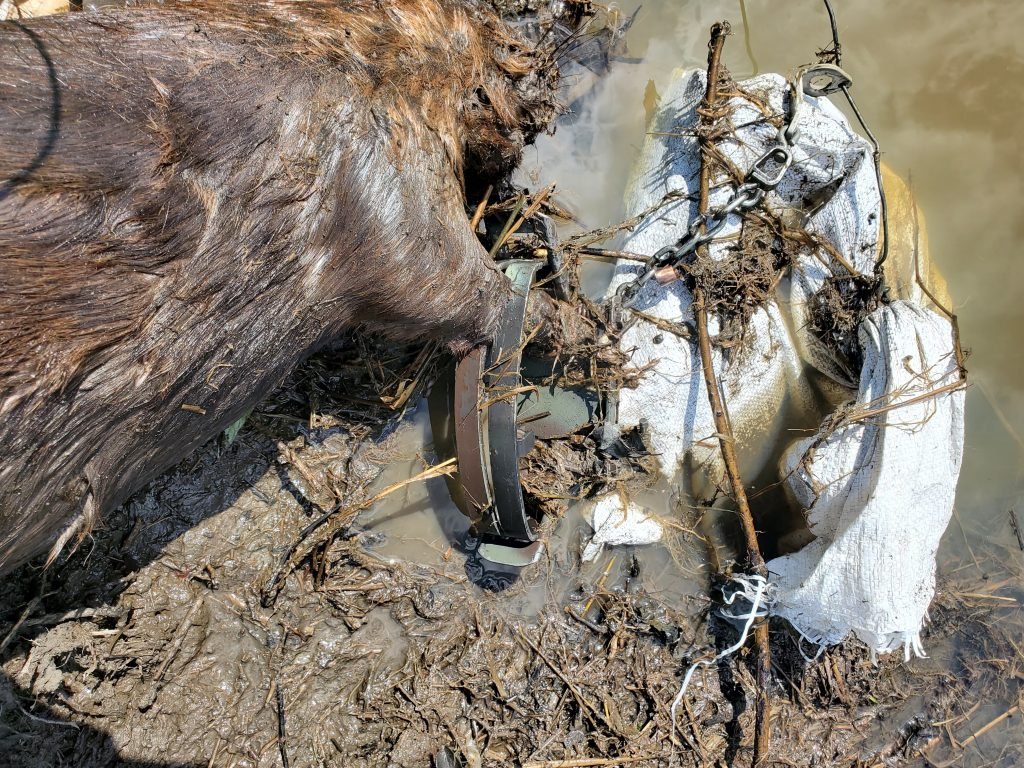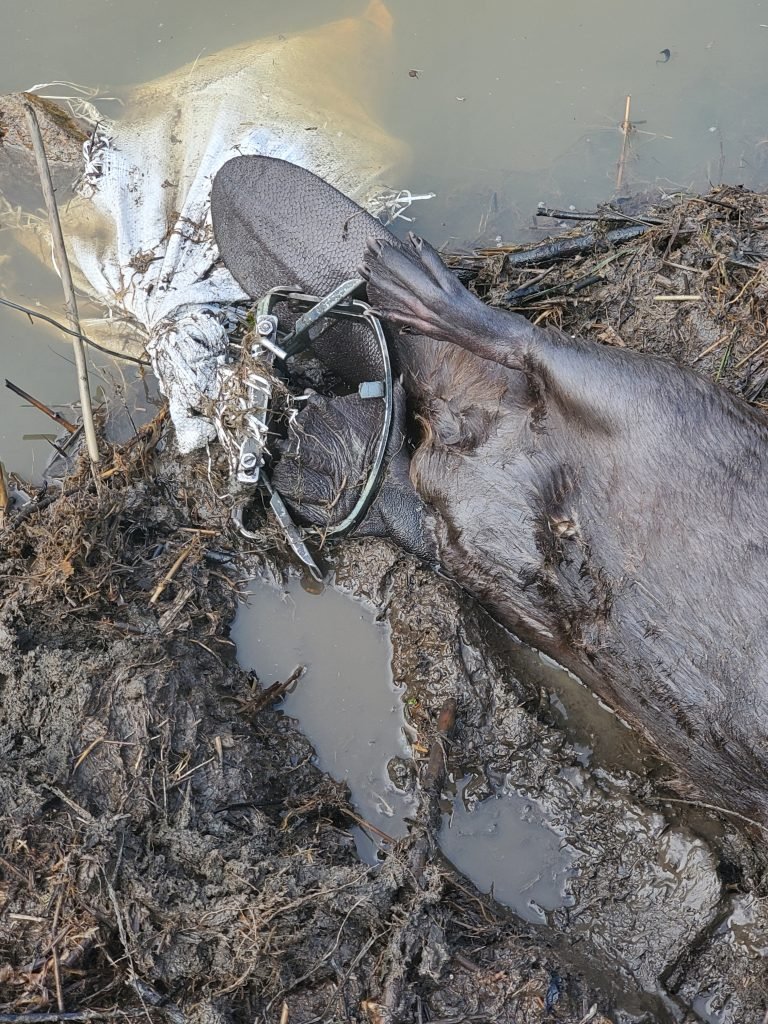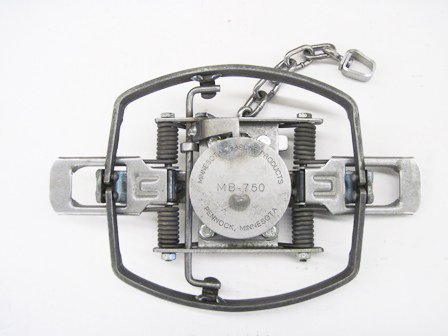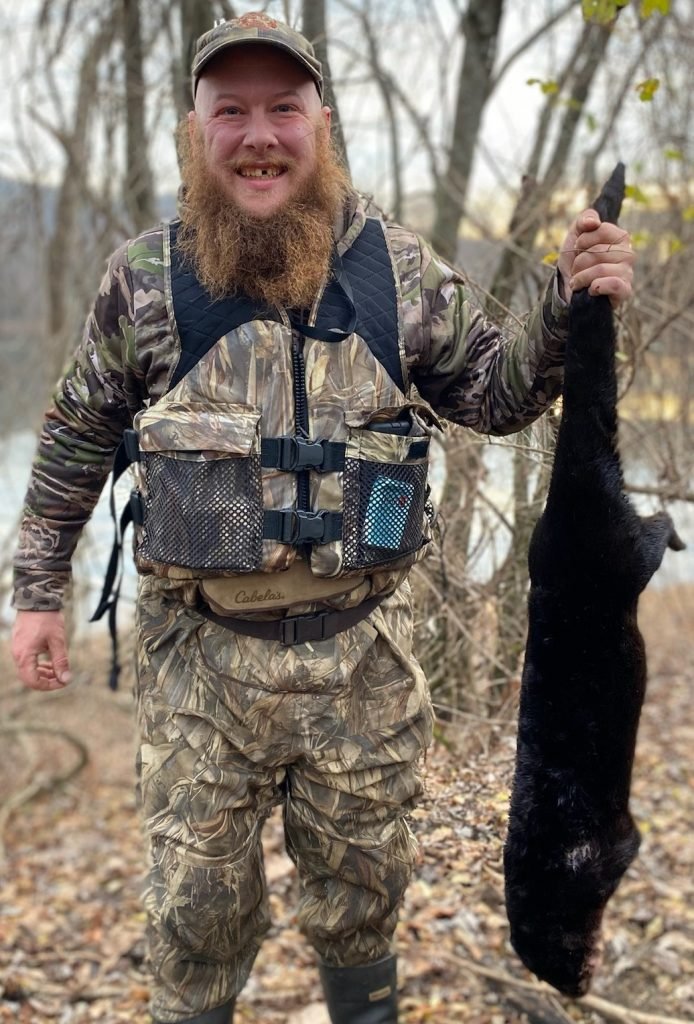This site is supported by you, the reader. If you make a purchase through one of my links, I may earn a small commission. Learn more here.
MB-750 Overview
-Made by Minnesota Trapline Products
-Designed for Beaver and Otter
-Jaw Spread: Inside 7 1/16″, outside 7 3/8″
-Pan size: 3″x3″
-Comes with HD machine chain and two swivels
-All models are standard 4-coiled
-Weighs about 4 lbs.
Review by Pat Connelly from Connelly Wildlife Management
Although it’s been out for a few years now, I recently tried out the MB-750 beaver trap. I used some doing summer control trapping for a railroad. I have many pros and some cons that may help you decide if they hold a place in your pack basket this spring.
I was called to do a control job for a railroad where a half-collapsed culvert, coupled with some busy beavers, were quickly compromising the tracks. I had gotten the MB-750’s for a strange reason. Without giving too much away, I was going to try to modify them into a sort of mini Bailey’s style suitcase for live catching muskrat and mink for use in my home state of Massachusetts. This would involve enlisting the assistance of a machinist buddy and cutting and modifying the jaws. Only one problem. It was an insurmountable issue. They’re just too damn pretty! I couldn’t bring myself to molest such a well made trap.
To start off the pros, I really like how Minnesota Brand tries to use United States-made parts whenever possible and that they’re assembled right here in the States. The trap has a solid heft to it, which I noticed when first picking one up. The trap’s construction leaves little doubt to its durability. The standard MB-750 beaver trap has a jaw spread measuring 7-1/16” inside and 7 3/8” outside. Add to this a 3”x3” pan, and I definitely was drawn to the respectable sized catch area.
These traps bed really well, even in a mucky swamp. A few test fires with the old Sullivan Trap Tester put the pan tension just over the max measurable line on the tester (which is about four pounds). They fire with some tenacity (I mean like shockingly quick!), no doubt because of their 4-coil design. I was running these on grain bags filled with rocks, a 9 gauge wire drowner and the new Hagz Universal Lock.

The two beaver I caught made their terminal dive almost without a hitch. The first was front foot caught, which was certainly a fluke because I’d set for a back foot catch. These things happen, I suppose. The railroad crew had fashioned two pieces of livestock fencing making the square culvert the base of a sort of triangle when looking down at it. This was an attempt to exclude the beavers nonlethally before I was called. The beaver had used this almost like concrete fencing and packed it with mud and sticks. I repositioned the two 750’s, one in front of each piece of fencing a bit further back, hoping to grab their back foot. The next check I had another approximately 40 pound beaver waiting for me. This one had all but one toe in the trap and was held solid.
Some of the pros I found with the MB-750 may actually be cons under certain circumstances. The traps are powerful. I would strongly recommend laminations if using on land or in non-drowning sets, due to potential animal welfare and trapping public relations concerns. Along those lines, the dogless design means you have to put your mitts in harm’s way when setting this trap. If I can make it my whole trapping career and not join the 330 club or the 750 club I’ll be a happy man!

Another qualm with setting is I had difficult time setting these by hand out of the box…and still do to this day. I like to consider myself of decent strength and stature but it’s not an easy task. The pair of A-shaped MB setters work really great in most instances. I would position the cross section over the lever and the bottom side of the A under the springs on both sides. You can then use the back of your knee/thigh and one hand while leaving your least favorite hand set the cross bar and pan in the danger zone. Relying on setters to me means one more thing to forget at the truck or lose in a swamp. A length of paracord tying them together so you can wear them around your neck and tuck into your chest waders might do the trick to mitigate this risk. I did have success depressing the levers with my toes while positioning the bar that catches the tabs on the jaws and then positioning the pan. This of course is not helpful unless you have semi-firm ground that is often a rarity in beaver territory. Wet and muddy boots or traps increase the difficulty of this method.
Overall the MB-750 is a robust, fast firing tank of a trap. This might be a bit overkill for beaver. As I said before, laminations may be essential if you’re aiming for a front foot catch. The dogless design prevents beavers from flipping the inactive jaw, but puts your hands in the line of fire when setting the trap. You may enjoy the speed and holding power but have difficulty setting it over your knee. Like anything, there are compromises to be weighed before you decide. What isn’t compromised is this trap’s ruggedness. These won’t be the only footholds in my beaver trapping arsenal, but they’re too damn pretty to get rid of either!


[…] Related: MB-750 Beaver/Otter Trap Review […]